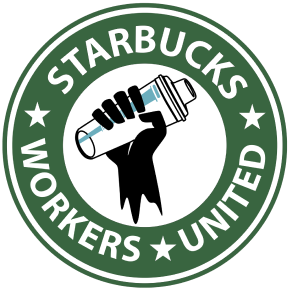“Basically, we looked at each other and agreed, either we all have to quit or something has to change!”
Caide had been working at Hex&Co. for about a year before contacting the Emergency Workplace Organizing Committee (EWOC). After a particularly difficult shift, his roommate recommended EWOC. He’d taken part in a successful EWOC-supported organizing campaign at REI in New York. That night, Caide filled out the intake form on the EWOC website. Within a few days, he got a call from the EWOC team, and the organizing campaign had begun.
Working at Hex&Co.
Hex&Co. is a board game café with almost 80 workers across three New York City locations: the East Side, the Upper West Side, and Union Square. The chain charges around $10 for access to the café to play board games and enjoy light meals and drinks.
The owners of Hex&Co., Jon Freeman and Greg May, also own similar businesses near NYU and in Brooklyn. Caide described a close-knit group of employees struggling to make ends meet doing a job they often loved. Many workers are students or have other jobs. Others live at home with their parents because Hex&Co. pays them an unlivable wage without health insurance.
Sasha, an undergraduate student, works at the Upper West Side location for supplemental income. She applied to work in their after-school program “because that’s what I love doing,” she says. “I love teaching kids.” The after-school program staff are responsible for providing instructional care for young children after school and for summer camp events.
Community Support
Caide, a long-time cafe worker, describes Hex & Company as a great place to work.
“Everyone who works at Hex loves it,” he says. “You can make great friends there. It’s a great community. You really get to explore your hobbies in the world of tabletop and board games. A lot of people who like board games and tabletop games rarely get the opportunity to actually engage with their hobby at all, let alone at work. You have to find people that want to play these games, and they have to go somewhere. Hex provides all that.”
Returning customers at all the locations love frequenting the cafés and the staff. Workers credit Freeman and May for having the initial vision. It created an amazing community of kinship based on their passion project, but that passion and community aren’t enough to ensure that a job has decent working conditions and livable pay.
Degraded Conditions
During Caide’s first year at Hex&Co., the conditions continued to get worse while the pay remained relatively stagnant, making the job unsustainable as a long-term income stream. Caide recounts, “We were led with a lot of promises, and those promises were never fulfilled.”
Their fears of being fired were compounded by their fears of losing their connection to Hex&Co. Many workers felt that if they no longer worked there, the community would ostracized them — as if losing their income wasn’t bad enough, they might also lose all of their friends.
Management pitted staff against one another with individual raises and special treatment for a select few. Without a clear path to promotion, new workers began to feel that the only way to get a raise was by appealing one-on-one to the owners and pleading for their own situations. Additionally, as the turnover rate continued to rise, those who stayed found that covering the remaining shifts became untenable.
Front-of-house staff act in multiple roles during one shift — barista, server, event coordinator — and management could often ask them to serve skeleton shifts that were badly understaffed. Tips were divided evenly among staff, but those on night shift tended to work busier shifts with fewer tips while morning hours were easier.
All of this meant they needed to organize for their own needs and interests as workers.
The Workplace Organizing Team
EWOC assigned Harry and Debra as organizers to the Hex&Co. campaign. Caide recalls:
“At first I thought, ‘This should be a fairly simple process. I’ll contact EWOC and I’m sure they’ll do something,’” he said, “but that’s not how it works at all. I learned the hard way. The reality of organizing is very much grassroots. There’s no real legal formula to do it. You learn as you do it, and I did learn. A LOT. I started from zero.”
Harry is a former journalist who first reached out to EWOC for help organizing a cabinetry shop he was working at. After getting some experience organizing with a New York union, he came on board as an EWOC volunteer. The Hex&Co. campaign was Harry’s first organizing effort with EWOC.
Debra has an impressive CV within the labor movement. She began organizing in the 1980s with SEIU and the National Association of Working Women in NYC, then as an organizer within several storied New York unions while earning a masters degree in labor relations. She later worked for the Professional Staff Congress (PSC) as the director of contract administration and was an adjunct lecturer in Cornell’s Industrial Labor Relations programs. After retiring in 2018 from the PSC, she began researching her ancestry, learning that her grandmother, Anna Stern Bergen, was the executive secretary of the Bronx Socialist Party in the 1920s. The fighting spirit was in her blood!
Debra volunteered with EWOC after hearing Chris Smalls, the founder of the first Amazon Labor Union in Staten Island, mention that EWOC supported them. She was ready to get involved again!
Debra credits Harry with much of the day-to-day communications and follow-up needed to support an organizing effort while Debra led meetings that involved educating different groups of workers about their rights.
Organizing Conversations
Caide affectionately describes his interactions with Debra and Harry as therapy sessions. “They would never give me answers; they would just ask me the right questions. And then I would have to go and find those answers. They wouldn’t say, ‘Go find 10 people and bring them here and we’ll talk to them.’”
“I would come home from work,” he said. “They would call me, and they would ask me, ‘Who at your job is the most frustrated. And who do you believe will support these ideas that you have?’” It was this long process of them teaching me how to organize and at the same time, getting me to act. I would then take what I learned and give other people this boiled-down, quick explanation to get them inspired. It was like this game of telephone. I would be told something, and I’ll feel very confident about what I would know, and then tell someone else, and I did that over and over and over again.”
Organizing Nuts and Bolts
The work of organizing Hex&Co. took over a year. Caide talks about a great deal of administrative tasks such as keeping meticulous notes of their activities, researching pamphlets, guides, articles on the EWOC resource page, and maintaining a workplace chart, a tool that Caide playfully calls their “bible.”
“That document was always on my desktop,” he said. “Every day, I would look at it, seeing who I needed to call, seeing what was happening next. It’s so vital. There is no organizing campaign without detailed plans and information.”
Harry also took detailed organizing notes during his meetings with Caide and the organizing committee (OC). He tracked the slow and methodical progress of bringing more people on board. They needed influential leaders who were not necessarily outgoing but friendly and trusted by co-workers. They needed to find ways to talk to them about the issues pervasive at Hex&Co. This part of the process came naturally as most employees enjoyed spending time together outside of work hours, playing board games and venting about recurring problems. The continual change of burned-out workers leaving Hex and new workers joining compounded the challenges.
Changes at Work
When asked if there were any moments where he felt like this was not going to work out, Caide exclaims, “Oh yes!” in a deceptively upbeat tone. “Almost all the time, like most of the time, sadly, it’s this feeling that this won’t work because it’s just too much.”
Even though he knew that everyone’s heart was in it, Caide felt the enormity of getting all the moving parts and the almost 80 workers in three locations to act all at once without management finding out. At the same time, Caide explains that during this time, “Not a lot is happening, right? Like, I’m still frustrated about my job. I still want changes to happen, but you can’t expect change to just happen.”
That spring, Harry and Debra stopped hearing from Caide and the organizing committee. Hex&Co. opened a new location in Union Square and shuffled many of the workplace leaders into new positions. For a while, the workers waited to see if anything would change at the new location.
New Organizers
Caide remembers feeling extremely demoralized when Joe, a new co-worker, approached Caide and asked to get involved in the campaign. Caide frankly told Joe, “I’ve been at this for months, and it’s been, in my opinion, almost a complete failure. If you want to take a crack at it, I think you should give it a shot.” Joe joined the organizing committee, and they both began meeting with Harry and Debra.
Soon after, Sasha and Zev joined the staff as part of an after-school program, breathing new life into the campaign. By September, a new organizing committee had formed, which included new employees, Sarah and Adam, each taking leadership roles within the committee. Even though Caide, at this point, had taken a step back from the new organizing committee, there was a renewed commitment to the cause.
“And that’s the idea, right? That’s why we do this,” Caide declares. “It’s not about what the individual person could bring to the table. My skills alone were not able to do this at all. It was the collective skills of everyone at Hex that got this done.”
The new organizing committee turned to their co-workers for a variety of tasks: data trackers who created detailed spreadsheets, artists who designed their logo and T-shirts, creative writers who wrote their speeches, and even influential leaders who excelled at connecting with others. Learning about and utilizing the talents of all their co-workers was a highlight of the campaign.
Drafting a Petition
The OC drafted a petition based on the concerns they had heard from their co-workers and set out to get a supermajority of the workers at all three locations to sign on. The essential parts of the petition requested higher wages, adequate staffing during high traffic shifts, and a clear path to promotions and raises and recognition as a bargaining unit.
The petition did not mention unionizing. The organizing committee had hoped that management would recognize their demands as collective without the need for “the U-word,” especially since an overwhelming number of their co-workers agreed that these changes were necessary. When 70 percent of Hex&Co. workers had signed on, they delivered it to management, going public with a campaign that had been months in the making.
That night, the owners rejected every demand. They denied that they had any power to honor the petition and, in an ironic twist of events, said that they would not negotiate unless the workers formed a union. The owners claimed that organizers had harassed other workers to sign the petition and thus they could not bargain with the organizing committee until they won a union election. This was an obvious lie. Why couldn’t an owner give their employees a raise? It forced the workers’ hands.
Emergency Meeting
The organizing committee called an emergency meeting at a park near the Upper West Side location with as many of the employees that could gather in one place as possible. They quickly weighed the pros and cons of creating an independent union or affiliating with an established union and took a vote. Unanimously, they decided to unionize with Workers United. They’d completed the uphill struggle of winning over hearts and minds.
EWOC had connected with Workers United through members at Barboncino, another EWOC campaign. In July, Barboncino workers voted to become New York City’s first unionized pizzeria. Workers United had sent two organizers to meet with Hex&Co. employees. They showed up with only six agendas expecting to meet a small organizing committee and instead were greeted with 30 workers ready to sign union cards.
Sasha had initially believed the owners would comply with the petition. When they didn’t, she realized that they needed to push for a union. For Zev, this wasn’t an “us against them battle.” “None of our actions were motivated by ill-will towards our employers. It was motivated by a desire to make our workplace better.” Both Sasha and Zev came from pro-union families, so they were not uncomfortable with unionizing by any measure.
Caide, on the other hand, grew up in Florida in a conservative household, which brought a unique perspective. Caide describes moments when his co-workers agreed with the petition but did not want to get involved. “It kind of hurts, but you can’t take anything personally,” Caide advises. “You have to understand how people grew up and how they carry those beliefs into adulthood.”
Winning a Union
Just one week after the emergency meeting, more than 70% of their co-workers had signed union cards. Armed with that support, a group of 20 marched on the boss and delivered a formal demand for union recognition. A few months later, the employees at Hex&Co. won their union election, 50–16, and became Hex Workers United.
It wasn’t a matter of winning over everyone; it was about getting as many people as possible to agree with the petition, to inoculate them against fears of retaliation, and to educate them into understanding the power of standing together. “We’re still very good friends,” explains Caide. “We all hang out. We all party together. We all play board games together.” The union is here to help them too.
Sasha also feels incredibly proud of her co-workers, how hard they worked, and how they came together in the end. This process has only made them closer.
Contract Negotiations
After their holiday party, Hex Workers United will begin the hard work of putting together a bargaining committee and then hashing out a contract with their employers. Harry’s last entry in the organizing notes modestly records the union win and wistfully reports public campaigns at the other two board game cafés owned by Freeman and May.
This is, however, the moment when Harry and Debra move on to new campaigns. As a relatively new organizer working on one of his first campaigns, Harry found it all to be incredibly exciting and challenging, at times.
“The campaign was pretty all-consuming for those last few weeks,” Harry said, “fielding questions, constantly strategizing OC calls, coordinating with EWOC legal teams and others on our Slack channels, watching the Discord pretty closely, following the campaign and getting stressed about it.”
From Debra’s perspective, after having spent her last years in the labor movement as an educator and administrator, she enjoyed returning to labor organizing and understood EWOC’s organizing model. “It’s a worker-led approach, from the bottom up, rather than the union leading the campaign from the top down,” Debra explains. She enjoyed working with the Hex&Co. organizing committee building their movement. When Workers United stepped in, they won their election and achieved full union recognition.
Future Organizing
As for EWOC, although we’ve moved on to other campaigns, we’re keeping a close eye on Hex Workers United because all workers are connected by our shared struggle. Hex&Co. will always be a part of our family of organizers, as will REI, Barboncino, and Amazon.
We hope you join us too! There’s a place for you and your skills at EWOC. Any amount of organizing experience is welcome, and you’ll be a part of a truly inclusive community that cares about fighting for your liberation in the workplace. We encourage you to sign up for our organizer training and donate to help keep our work going.




